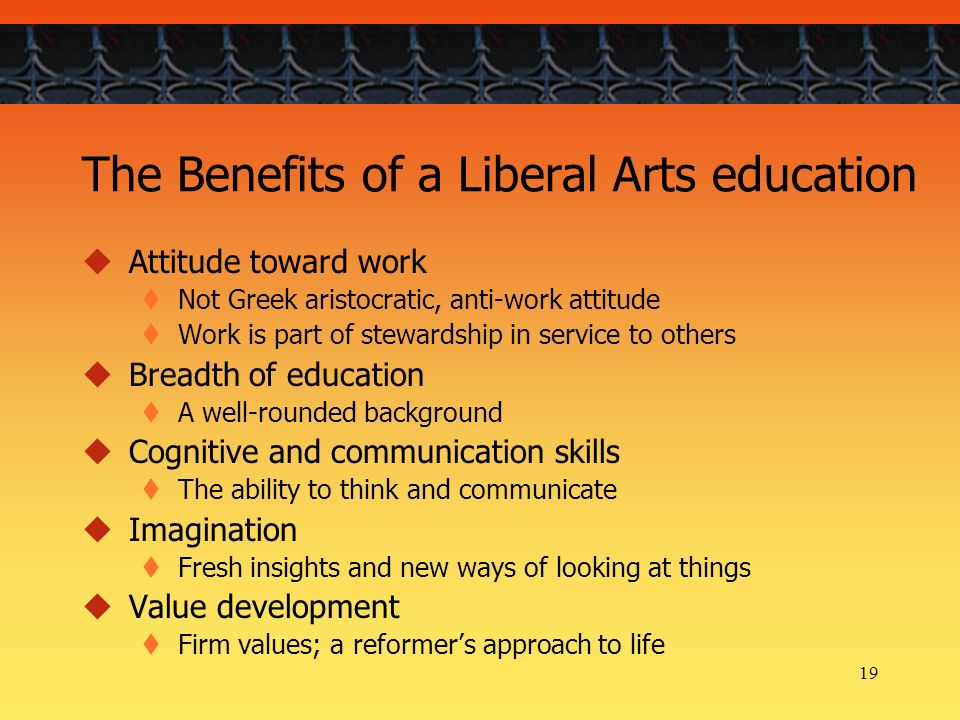A liberal arts education is a traditional academic program in Western higher education. It emphasizes breadth and depth. The broad curriculum prepares students to analyze ideas from multiple points of view and to engage in classes and discussions that are outside the scope of their field of study. The program also gives students a broad perspective and opens up career options. Listed below are the advantages of a liberal arts education. To learn more about what this type of education entails, read on.
It emphasizes depth and breadth
The Liberal Arts model is a holistic approach to learning. Rather than focusing on one specific subject or area of study, liberal arts students are encouraged to take at least half of their coursework in a field other than their major. The philosophy behind liberal arts education is that there are many lenses to view the world, and each one is worthy of consideration. This approach provides undergraduates with the opportunity to explore various worldviews and compare them.
In order to implement the Socratic method in a university, instructors must be properly trained. While the concept is still widely used in some countries, it is rarely practiced, as the primary delivery mode of the breadth requirement remains the large lecture. For example, at some elite universities, competence in Latin and Greek was required for admission. Regardless of whether an institution embraces the Socratic method, it must also include mechanisms that encourage students to read before class.
It requires students to engage in classes and discussions beyond their given scope of study
The liberal arts are comprised of various disciplines. Liberal arts education encourages conversational thinking, creative expression, and a broader worldview. Regardless of the discipline, liberal arts education prepares students for careers that demand creative thinking and problem-solving abilities. More employers recognize the soft-skills liberal arts students bring to the workplace. Here are a few reasons why.
The roots of the liberal arts education can be traced to the Ancient Greeks, who regarded a broad education as the ultimate sign of an educated person. It has been firmly established in US higher education, but has only recently begun to return in continental Europe, where it first took hold. Today, liberal arts education has spread beyond North America and has become a hallmark of respected educational institutions.
Liberal arts education is a springboard to an independent life. Because liberal arts students are expected to engage in classes and discussions outside their given scope of study, they are encouraged to question their goals and ideas about success and failure. Many liberal arts students go on to pursue careers that don’t directly align with their chosen major. In these situations, liberal arts education can be an ideal foundation for independent thought and growth.
It prepares students to examine ideas from multiple points of view
A liberal arts education cultivates innovative thinking skills. In English, students may study a story for its underlying meaning or as an interaction between the author and reader. History majors might study world events from different perspectives. Liberal arts students are often asked to challenge conventional ideas and the status quo. In an increasingly competitive job market, innovators and thinkers who can work outside the box are highly sought after by employers.
The roots of liberal arts education are visible in the ancient Greek and Roman philosopher-educators. Today, students study a wide variety of disciplines that gather under this umbrella. They learn to examine ideas from multiple points of view, engage in creative thinking, and engage in interdisciplinary conversations that challenge assumptions. Students gain the skills necessary for success in a career or a satisfying life. Here are some of the advantages of a liberal arts education.
It opens up career opportunities
Whether you are considering a career in the arts or in the sciences, a liberal arts education can open many doors. Students who major in the humanities and social sciences develop critical thinking skills that will serve them well in many fields. Those who major in English, history, and literature will be equipped to better understand the human dynamics that affect stock market flow. The Knoxville News Sentinel reports that liberal arts graduates often land 10 different jobs by the time they reach 40. These opportunities don’t just open up doors for those who are seeking jobs but also give students an edge over those without the same training.
With the explosion of information technology, there are many new ways for doctors to treat diseases. However, when high-tech treatments are used on patients, a human touch can be lacking. Meanwhile, ethical issues are looming in the background of DNA-based therapies. The communications issues posed by such technology can be enormous roadblocks. A liberal arts degree is highly valued by employers in the biotechnology and healthcare industries. This is because many employers want graduates with strong communication skills.

